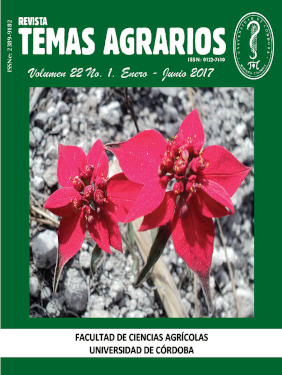Implementation of a method of extraction conditions of pectin obtained fromagroindustrial by-product cocoa husks
Implementación de un método de extracción de pectina obtenida del subproducto agroindustrial cascarilla de cacao

This work is licensed under a Creative Commons Attribution-NonCommercial 4.0 International License.
Show authors biography
Pectin is a polysaccharide with hydrocolloidal, gelling and stabilizing characteristics. It is widely used in the manufacture of cosmetics, food products, and pharmaceuticals, among others products. Taking into account this wide range of applications in several industries, this study sought to evaluate national cocoa husks (Theobroma cacao Linneo), a waste of difficult disposal, as a source of this natural polymer. The study also attempted to determine the best conditions for the extraction process. The cocoa husks are from a national industry and comprise different materials (Criollo, Forastero and Trinitario). A reflux extraction method using citric acid was implemented. Preliminary tests took different periods of time (100, 95, 85 and 75 minutes) and were conducted at different temperatures (95, 90, 80 and 70 ºC). A test of variance was made using 22 design and employing the highest percentages of methoxyl and galacturonic acid. The pectin extraction yield increased proportionally with time and temperature. However, the percentage of methoxyl did not show an important variation (2.65%±0.16 and 2.90%±0.03). The pectin obtained was characterized as one of low methoxyl pectin content. The best extraction temperature condition using a citric acid solution of pH 3 was 70 °C hold during 95 minutes. Under this condition a yield of 8.82 g pectin / 100 g cocoa husks was obtained, the esterification degree was 71.88%±0.78, and the percentage of galacturonic acid was 26.86%±0.86. These results show that the husks from the national cocoa industry can be included among the alternative sources to obtain pectin.
Article visits 2635 | PDF visits
Downloads
- Axelos, A. y Thibault, F. 1991. The chemistry of low-methoxyl pectin gelation. The chemistry and technology of pectin. 6:109-108.
- Baena, M. y García, N. 2012. Obtención y caracterización de fibra dietaría a partir de cascarilla de las semillas tostadas de Theobroma Cacao L. de una industria chocolatera colombiana. Química Industrial. Universidad Tecnológica de Pereira. Colombia.
- Barazarte, H., Sangronis, E. y Unai, E. 2008. La cáscara de cacao (Theobroma Cacao L.): una posible fuente comercial de pectinas. Archivos Latinoamericanos de nutrición. 58(1):64.
- Canteri, M., Moreno, L. y Wosiacki, G. 2012. Pectina: da matéria-prima aoproduto final. Polímeros. 22(2):149-157.
- Cuellar, O. 2010. Obtención del extracto polar etanol: agua (1:1) de la cáscara de cacao y evaluación de su actividad antibacteriana. Investigación. Universidad Tecnológica de Pereira. Colombia.
- Marsiglia, D., Ojeda, K., Ramirez, M. y Sánchez, E. 2016. Pectin extraction from cocoa pod husk (Theobroma Cacao L.) by hydrolysis with citric and acetic acid. International Journal of Chem Tech Research. 9(7):497-507.
- Mollea, C., Chiampo, F. and Conti, R. 2008. Extraction and characterization of pectins from cocoa husks: A preliminary study. ºFood Chemistry. 107(3):1353-1356.
- Ranganna, S. 1986. Handbook of analysis and quality control for fruit and vegetable products. (2Ed).
- Tata McGraw-Hill Education. p 32-34. Sangoris, E., Soto, M., Valero, y Bucema, I. 2014. Cascarilla de cacao Venezolano como materia prima de infusiones. Archivos norteamericano de nutrición. Caracas, Venezuela. 64(2):123-130.
- Schieber, A., Stintzing, F. and Carle, R. 2001. By-products of plant food processing as a source of functional compounds recent developments. Trends in Food Science & Technology. 12(11):401-413.
- Silva, N., Benites, E. y Gomero, J. 2008. Extracción y caracterización de pectinas obtenidas a partir de frutos de la biodiversidad peruana. ºIngeniería Industrial. 26:175-199.
- Superintendencia de Industria y Comercio. 2011. Cadena productiva del cacao: diagnóstico de libre competencia. Bogotá:
- Superintendencia de Industria y Comercio.
- Useché, J., Jacobo, A., Agudelo, J., Mendez, J., Rojas, F., Ramirez, O., et al. 2009. El reto es por la productividad. Colombia Cacaotera. Bogotá, Colombia.4:8-9.
- Vriesmann, L., Teófilo, R. and De Oliveira, C. 2011. Optimization of nitric acidmediated extraction of pectin from cacao pod husks (TTheobroma Cacao L.) using response surface methodology. ºCarbohydrate Polymers. 84(4):1230- 1236.
- Vriesmann, L., Teófilo, R. and De Oliveira, C. 2012. Extraction and characterization of pectin from cacao pod husks (Theobroma Cacao L.) With citric acid.Food Science and Technology. 49(1):108-116.




















